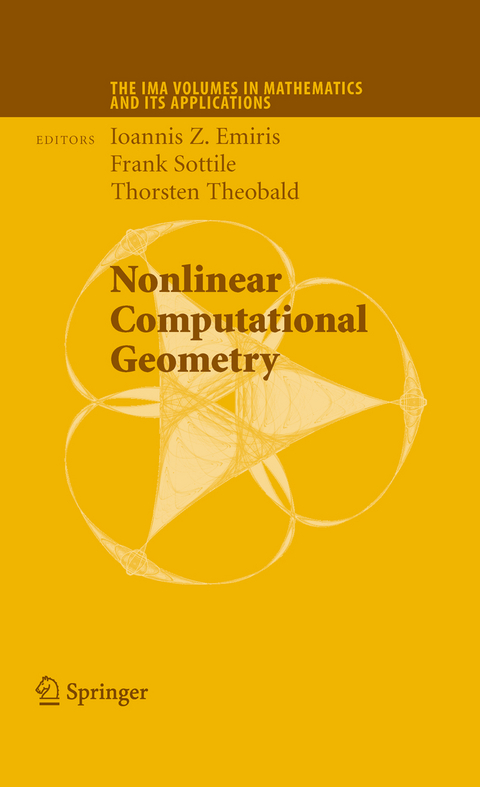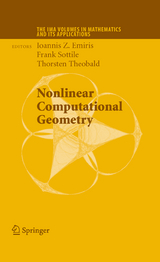Nonlinear Computational Geometry
Seiten
2009
Springer-Verlag New York Inc.
978-1-4419-0998-5 (ISBN)
Springer-Verlag New York Inc.
978-1-4419-0998-5 (ISBN)
These research efforts may be summarized under the term nonlinear computational geometry.This volume grew out of an IMA workshop on Nonlinear Computational Geometry in May/June 2007 (organized by I.Z.
An original motivation for algebraic geometry was to understand curves and surfaces in three dimensions. Recent theoretical and technological advances in areas such as robotics, computer vision, computer-aided geometric design and molecular biology, together with the increased availability of computational resources, have brought these original questions once more into the forefront of research. One particular challenge is to combine applicable methods from algebraic geometry with proven techniques from piecewise-linear computational geometry (such as Voronoi diagrams and hyperplane arrangements) to develop tools for treating curved objects. These research efforts may be summarized under the term nonlinear computational geometry.
This volume grew out of an IMA workshop on Nonlinear Computational Geometry in May/June 2007 (organized by I.Z. Emiris, R. Goldman, F. Sottile, T. Theobald) which gathered leading experts in this emerging field. The research and expository articles in the volume are intended to provide an overview of nonlinear computational geometry. Since the topic involves computational geometry, algebraic geometry, and geometric modeling, the volume has contributions from all of these areas. By addressing a broad range of issues from purely theoretical and algorithmic problems, to implementation and practical applications this volume conveys the spirit of the IMA workshop.
An original motivation for algebraic geometry was to understand curves and surfaces in three dimensions. Recent theoretical and technological advances in areas such as robotics, computer vision, computer-aided geometric design and molecular biology, together with the increased availability of computational resources, have brought these original questions once more into the forefront of research. One particular challenge is to combine applicable methods from algebraic geometry with proven techniques from piecewise-linear computational geometry (such as Voronoi diagrams and hyperplane arrangements) to develop tools for treating curved objects. These research efforts may be summarized under the term nonlinear computational geometry.
This volume grew out of an IMA workshop on Nonlinear Computational Geometry in May/June 2007 (organized by I.Z. Emiris, R. Goldman, F. Sottile, T. Theobald) which gathered leading experts in this emerging field. The research and expository articles in the volume are intended to provide an overview of nonlinear computational geometry. Since the topic involves computational geometry, algebraic geometry, and geometric modeling, the volume has contributions from all of these areas. By addressing a broad range of issues from purely theoretical and algorithmic problems, to implementation and practical applications this volume conveys the spirit of the IMA workshop.
Spectral Techniques to Explore Point Clouds in Euclidean Space, with Applications to Collective Coordinates in Structural Biology.- Rational Parametrizations, Intersection Theory, and Newton Polytopes.- Some Discrete Properties of the Space of Line Transversals to Disjoint Balls.- Algebraic Geometry and Kinematics.- Rational Offset Surfaces and their Modeling Applications.- A List of Challenges for Real Algebraic Plane Curve Visualization Software.- A Subdivision Method for Arrangement Computation of Semi-Algebraic Curves.- Invariant-Based Characterization of the Relative Position of Two Projective Conics.- A Note on Planar Hexagonal Meshes.- List of Workshop Participants.
| Erscheint lt. Verlag | 7.12.2009 |
|---|---|
| Reihe/Serie | The IMA Volumes in Mathematics and its Applications ; 151 |
| Zusatzinfo | XI, 239 p. |
| Verlagsort | New York, NY |
| Sprache | englisch |
| Maße | 155 x 235 mm |
| Themenwelt | Mathematik / Informatik ► Mathematik ► Algebra |
| Mathematik / Informatik ► Mathematik ► Analysis | |
| Mathematik / Informatik ► Mathematik ► Angewandte Mathematik | |
| Mathematik / Informatik ► Mathematik ► Geometrie / Topologie | |
| ISBN-10 | 1-4419-0998-2 / 1441909982 |
| ISBN-13 | 978-1-4419-0998-5 / 9781441909985 |
| Zustand | Neuware |
| Informationen gemäß Produktsicherheitsverordnung (GPSR) | |
| Haben Sie eine Frage zum Produkt? |
Mehr entdecken
aus dem Bereich
aus dem Bereich
Buch | Softcover (2022)
Springer Spektrum (Verlag)
CHF 55,95




